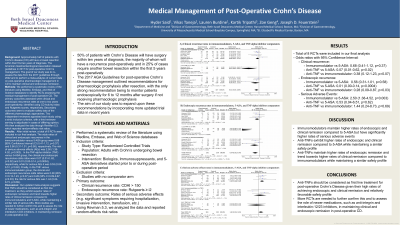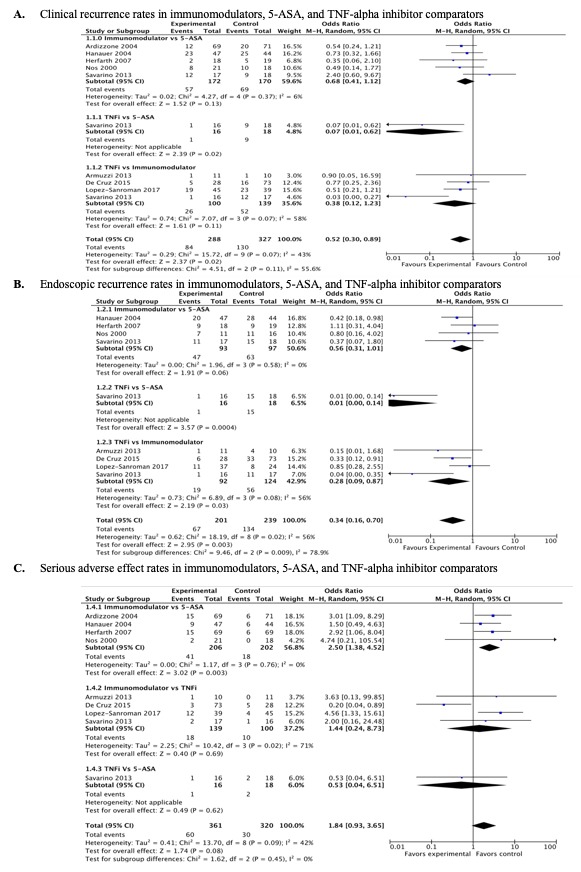Back


Poster Session E - Tuesday Afternoon
Category: IBD
E0352 - Medical Management of Post-Operative Crohn’s Disease
Tuesday, October 25, 2022
3:00 PM – 5:00 PM ET
Location: Crown Ballroom

Has Audio

Hyder Said, MD
Beth Israel Deaconess Medical Center
Boston, MA
Presenting Author(s)
Hyder Said, MD1, Vikas Taneja, MD1, Lauren Burdine, MD1, Kartikeya Tripathi, MD2, Zhuo Geng, MD3, Joseph D. Feuerstein, MD4
1Beth Israel Deaconess Medical Center, Boston, MA; 2University of Massachusetts Medical School - Baystate, Springfield, MA; 3St. Elizabeth’s Medical Center’s Medical Office Building, Brighton, MA; 4Beth Israel Deaconess Medical Center (BIDMC), Boston, MA
Introduction: Approximately half of patients with Crohn’s disease (CD) will have a bowel resection within their first ten years of diagnosis. The American Gastroenterological Association released guidelines in 2017 for post-operative Crohn’s management. The goal of our study was to re-assess the data from the 2017 guidelines through 2022 and to perform a meta-analysis of current data on post-operative pharmacologic management in CD to maintain clinical and endoscopic remission.
Methods: We performed a systematic review of the literature using Medline, Embase, and Web of Science databases to identify RCTs assessing the medical management of post-operative CD. The primary outcomes assessed were clinical and endoscopic recurrence rates at one to two years post-operatively, identified using CD Activity Index and Rutgeerts scores, respectively. Secondary outcomes were to evaluate safety data of the different pharmacologic approaches. Two independent reviewers appraised each study using a strict inclusion criterion, with a third reviewer serving to adjudicate in cases of differing opinion. We then analyzed the data through RevMan 5.3, which reported random-effects risk ratios.
Results: After initial review, a total of 8 RCTs were included in our final analysis. The odds ratios of clinical and endoscopic recurrence in the immunomodulator versus 5-ASA group were 0.68 [95% Confidence Interval (CI) 0.41-1.12, p=0.37] and 0.56 (0.31-1.01, p=0.58), respectively. The risk of serious adverse effects (AEs) was 2.50 (1.38-4.52, p=0.003). In the TNF-alpha inhibitor (TNF) versus 5-ASA group, the clinical and endoscopic recurrence odds ratios were 0.07 (0.01-0. 62, p=0.02) and 0.01 (0.00-0.14, p=0.0004), respectively, while for serious AEs it was 0.53 (0.04-6.51, p=0.62). Finally, in the TNF versus immunomodulator group, the clinical and endoscopic recurrence odds ratios were 0.38 (95% CI 0.12-1.23, p=0.07) and 0.28 (95% CI 0.09-0.87, p=0.03); the risk for serious AEs was 1.44 (0.24-8.73, p=0.69).
Discussion: Our updated meta-analysis suggests that TNFs should be considered as first line treatment, as they exhibit superior rates of endoscopic remission and trend towards higher rates of clinical remission compared to immunomodulators and 5-ASA, while maintaining a similar rate of serious AEs. More studies are needed to further confirm this and to assess the role of newer medications, such as anti-integrin and interleukin-12/23 inhibitors, in maintaining remission in post-operative CD.

Disclosures:
Hyder Said, MD1, Vikas Taneja, MD1, Lauren Burdine, MD1, Kartikeya Tripathi, MD2, Zhuo Geng, MD3, Joseph D. Feuerstein, MD4. E0352 - Medical Management of Post-Operative Crohn’s Disease, ACG 2022 Annual Scientific Meeting Abstracts. Charlotte, NC: American College of Gastroenterology.
1Beth Israel Deaconess Medical Center, Boston, MA; 2University of Massachusetts Medical School - Baystate, Springfield, MA; 3St. Elizabeth’s Medical Center’s Medical Office Building, Brighton, MA; 4Beth Israel Deaconess Medical Center (BIDMC), Boston, MA
Introduction: Approximately half of patients with Crohn’s disease (CD) will have a bowel resection within their first ten years of diagnosis. The American Gastroenterological Association released guidelines in 2017 for post-operative Crohn’s management. The goal of our study was to re-assess the data from the 2017 guidelines through 2022 and to perform a meta-analysis of current data on post-operative pharmacologic management in CD to maintain clinical and endoscopic remission.
Methods: We performed a systematic review of the literature using Medline, Embase, and Web of Science databases to identify RCTs assessing the medical management of post-operative CD. The primary outcomes assessed were clinical and endoscopic recurrence rates at one to two years post-operatively, identified using CD Activity Index and Rutgeerts scores, respectively. Secondary outcomes were to evaluate safety data of the different pharmacologic approaches. Two independent reviewers appraised each study using a strict inclusion criterion, with a third reviewer serving to adjudicate in cases of differing opinion. We then analyzed the data through RevMan 5.3, which reported random-effects risk ratios.
Results: After initial review, a total of 8 RCTs were included in our final analysis. The odds ratios of clinical and endoscopic recurrence in the immunomodulator versus 5-ASA group were 0.68 [95% Confidence Interval (CI) 0.41-1.12, p=0.37] and 0.56 (0.31-1.01, p=0.58), respectively. The risk of serious adverse effects (AEs) was 2.50 (1.38-4.52, p=0.003). In the TNF-alpha inhibitor (TNF) versus 5-ASA group, the clinical and endoscopic recurrence odds ratios were 0.07 (0.01-0. 62, p=0.02) and 0.01 (0.00-0.14, p=0.0004), respectively, while for serious AEs it was 0.53 (0.04-6.51, p=0.62). Finally, in the TNF versus immunomodulator group, the clinical and endoscopic recurrence odds ratios were 0.38 (95% CI 0.12-1.23, p=0.07) and 0.28 (95% CI 0.09-0.87, p=0.03); the risk for serious AEs was 1.44 (0.24-8.73, p=0.69).
Discussion: Our updated meta-analysis suggests that TNFs should be considered as first line treatment, as they exhibit superior rates of endoscopic remission and trend towards higher rates of clinical remission compared to immunomodulators and 5-ASA, while maintaining a similar rate of serious AEs. More studies are needed to further confirm this and to assess the role of newer medications, such as anti-integrin and interleukin-12/23 inhibitors, in maintaining remission in post-operative CD.

Figure: Rates of clinical and endoscopic recurrence and serious adverse effects associated with immunomodulators, 5-ASA, and TNF-alpha inhibitors for the maintenance of remission in post-operative CD.
Disclosures:
Hyder Said indicated no relevant financial relationships.
Vikas Taneja indicated no relevant financial relationships.
Lauren Burdine indicated no relevant financial relationships.
Kartikeya Tripathi indicated no relevant financial relationships.
Zhuo Geng indicated no relevant financial relationships.
Joseph Feuerstein indicated no relevant financial relationships.
Hyder Said, MD1, Vikas Taneja, MD1, Lauren Burdine, MD1, Kartikeya Tripathi, MD2, Zhuo Geng, MD3, Joseph D. Feuerstein, MD4. E0352 - Medical Management of Post-Operative Crohn’s Disease, ACG 2022 Annual Scientific Meeting Abstracts. Charlotte, NC: American College of Gastroenterology.
